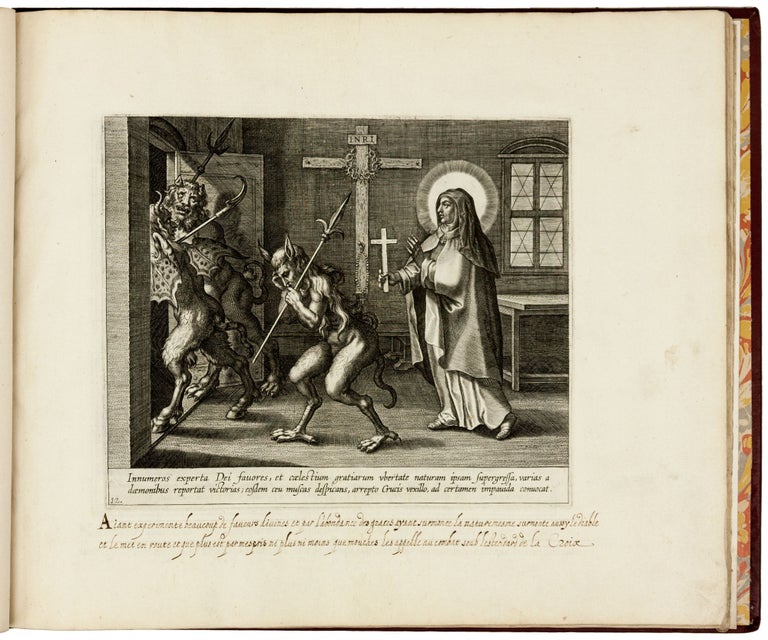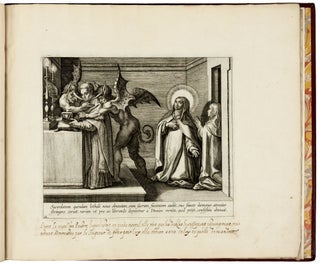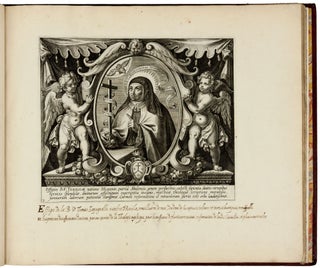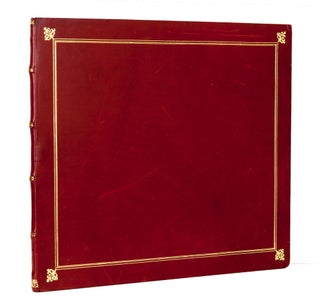Vita b. virginis Teresiæ a Iesv ordinis Carmelitarum.
Title & 24 engraved plates numbered 2-24. 14 plates signed by Collaert, 1 plate by Galle, the remaining are unsigned. Bound in red morocco, boards & spine tooled in gold, several scratches on back cover. Each plate is accompanied by an explanatory text in Latin and a manuscript translation in French in a fine contemporary calligraphic hand. Plates 23-25 with some soft creasing; plate 25 backed. Overall excellent. The very rare first edition of this suite of 24 engravings representing the life of Teresa of Ávila (1515-1582), designed by the prominent Antwerp engravers and print publishers Adriaen Collaert (c. 1560-1618) and Cornelis Galle I (1576-1650), issued on the eve of the beatification of Teresa in 1614. Following her canonization in 1622, the title in subsequent editions was altered to Vita S[anctae] Virginis Teresiae to reflect the sainthood of Teresa. Revered by the feminist icons Simone de Beauvoir and Julia Kristeva, the first female doctor of the church and one of the 100 “women trailblazers” according to Britannica, Teresa of Ávila was among the major religious reformers of the sixteenth century. She launched the Carmelite reform in 1562 by founding the first Discalced convent, San José de Ávila in Ávila, Spain. “Discalced” or barefoot meant to signal a return to an austere lifestyle of prayer. Despite opposition from the Calced Carmelites, the Church, and the king, Teresa managed to establish sixteen more Discalced convents during her life. In addition to Carmelite reformation, she is known for her writings, especially her autobiography, The Life of Teresa of Jesus as well as The Interior Castle and The Way of Perfection. Born to a successful silk and wool converso merchant (a Spanish Jew, who accepted Catholicism during the forced conversions of the late fifteenth century) and a Catholic woman of “old pedigree”, Teresa learned early to read and write and particularly enjoyed reading hagiographies. In her autobiography she writes that tales of martyrdom “once inspired her to escape from home with her brother Rodrigo in hopes of being decapitated by Moors. Although hagiographers traditionally interpret this incident as an example of her early piety, she herself describes it as more of a prank” [Mujica, p. 140]. This “prank” from her youth is depicted in plate 3 in this album. Researchers believe that Teresa may even have co-written a chivalric romance with her brother, called El caballero de Ávila [Mujica, p. 140]. As an adolescent Teresa enjoyed fashionable clothing and outings, yet she eventually became drawn to God. At 21, she entered the Carmelite Convent of the Incarnation, and two years later became a nun. The publication of these engravings was championed by Teresa’s disciple Ana de Jesús (1545-1621), an important female religious leader in her own right. After Teresa’s death, Ana assembled for publication the literary works of her teacher and helped found monasteries of the Discalced Carmelite nuns in Spain as well as in France, the Low Countries, and Poland. Around 1610, at the invitation of Infanta Isabella and Archduke Albert, both supporters of Counter-Reformation and the movement of Discalced nuns, Ana moved to Brussels, where she helped found a monastery of her order. In 1619, she assisted with the founding of the Discalced Carmelite monastery in Antwerp—the place of publication of these engravings. The album is dedicated to Don Rodrigo Niño y Lasso, Count of Añover, treasurer of Archduke Albert and Infanta Isabel Clara Eugenia. The engravings are based on the autobiography of Teresa. According to Saldanha, Ana de Jesús was responsible for choosing subjects for the plates. The selected episodes mostly illustrate mystic and ascetic facets of Saint Teresa’s life, especially her visions. The prints enjoyed great popularity and served as the foundational visual material for the dissemination of information about Santa Teresa, influencing many paintings and prints by other artists. In addition to giving a visual account of Teresa’s life, these finely engraved prints serve as a source of information on religious and lay clothing of the time, landscapes, city views, and interiors. The publishers of these engravings Adriaen Collaert and Cornelis Galle I came from two prominent families of engravers and print publishers based in Antwerp—the center for print production in Europe in the seventeenth century. The two printers were connected through marriage: Adriaen was married to one of Cornelis’ sisters. Cornelis’ father, Philips Galle was a close friend and occasional business partner of the famous printer Christopher Plantin. In addition to work ties, the Galles were connected to the Plantin-Moretus family through marriage. The Galle family specialized in various types of prints, including “more conventional devotional subjects, which became even more popular following the 1585 fall of Antwerp to Spanish troops and the subsequent thorough reimposition of the Catholic faith in the region” [Bowen, p. 127]. The Collaerts were another important dynasty of engravers and print publishers active in Antwerp in the second part of the sixteenth-first part of the seventeenth century. The vast print production of the three generations of the Collaerts amounts to more than 2200 prints. We have been able to locate a complete copy of the first edition of this important publication only in one U.S. institution—the Library of Congress which has an extraneous prelim not called for elsewhere.
* Our copy collates with OCLC 1122689760 and OCLC 1142870601. Hollstein, Dutch & Flemish etchings, engravings & woodcuts, ca. 1450-1700, vol. 4, 230-248 (lists 19 plates and a frontispiece and Theodore Galle as publisher instead of Cornelis Galle). Diels, The New Hollstein Dutch and Flemish, The Collaert Dynasty, part. 4, pp. 246-263, n. 1016-1040 (lists 24 plates and a frontispiece). Sandra Costa Saldanha, “Fontes para a iconografia teresiana no convento do Santíssimo Coração de Jesus à Estrela,” Cultura: Revista de História e Teoria das Ideias, vol. 21 (2005), pp. 101-126. Mujica, “Three Sisters of Carmen: The Youths of Teresa de Jesús, María de San José, and Ana de San Bartolomé,” in Cohen, Reeves, The Youth of Early Modern Women, pp. 137-157. Bowen, “Workshop Practices in Antwerp: The Galles,” Print Quarterly, vol. 26, no. 2 (2009), pp. 123–142.
Sold






